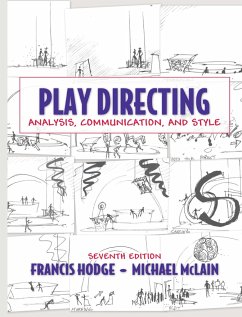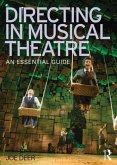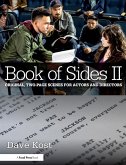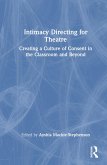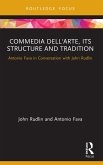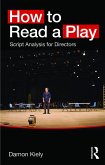Play Directing describes the various roles a director plays, from selection and analysis of the play to working with actors and designers to bring it to life.
The authors emphasize that the role of the director as an artist-leader collaborating with actors and designers who look to the director for partnership in achieving their fullest, most creative expressions. The text emphasizes how the study of directing provides an intensive look at the structure of plays and acting, and of the process of design of scenery, costume, lighting, and sound that together make a produced play.
Students are guided through the whole process of working on a play, from analysis from the director's point of view to understanding style in scripts and production options. Aspriring directors are encouraged to use this foundation as a basis from which to set their own goals as creative and dedicated leaders.
Product Description
Play Directing describes the various roles a director plays, from selection and analysis of the play to working with actors and designers to bring it to life. The authors emphasize that the role of the director is that of an artist-leader working in collaboration with actors and designers who look to the director for partnership in achieving their fullest, most creative expressions. The text emphasizes that directing is not a finite and specific "system" of production, but rather it is a means of providing an intensive look at the structure of plays, of acting, and of the process of design in the major areas of scenery, costume, lighting, and sound that together make a produced play.
Features + Benefits
Focuses on plays as central to the ongoing continuum of live theatre from its origin to the present. An Appendix contains a discussion of the director in musical theatre and opera.
Provides a smooth and logical progression of information from one dimension of play directing to another as it explores the director at work with actors, designers, and many other aspects of a production.
Gives the learning director detailed explanations for all the components of stage blocking, including drawings that clearly demonstrate the building blocks of making effective groundplans and evolving expressive compositions, picturizations, and movements, all of which are seen as powerful means of communicating with actors and audiences rather than as technical functions removed from the life of the play.
Emphasizes the importance of the director's understanding and mastery of style in both playscripts and production.
Describes how effective direction is essential at all levels of production, from the beginner, to the advanced director, to the professional.
Helps students build a solid foundation that will make possible their own creative approaches to directing as they master the fundamentals.
Dedication
Preface and Credits for Photographs.
1. Why the Director?
2. What Is a Play? Analysis and Improvisation.
I. PLAY-ANALYSIS: TAKING A PLAY APART.
3. The Foundation and Facade of the Playscript: Given Circumstances and
Dialogue.
4. The Core of the Playscript: Dramatic Action and Characters.
5. Idea and Rhythm-Mood Beats.
6. The Director's Preparation.
II. COMMUNICATION 1: THE DIRECTOR-ACTOR RELATIONSHIP AND STAGE BLOCKING
7. Directing Is Working with Actors 1.
8. Learning to See: The Games of Visual Perception.
9. Helping Actors Communicate through Groundplans.
10. Composition: Helping Actors Discover and Project Basic Relationships.
11. Helping Each Actor Intensify: Gesture and Improvisation with Properties.
12. Picturization: Helping a Group Intensify.
13. The Dynamic Tool of Movement.
14. Coordinating the Blocking Tools in Director-Actor Communication.
15. Helping Actors "Speak" a Play
16. Directing is Working with Actors 2.
Major Project 1A: Scene Practice.
Major Project 1B: Diagnostic Criticism.
COMMUNICATION THROUGH STAGING OPTIONS .
17. The Director's Responsibility for Working Effectively with Design.
18. The Director and the Stage Machine: Symbolization and Synthesis.
19. Director's Options: Choice of the Stage.
20. Director's Options: Scenery, Properties, and Lighting.
21. Director's Options: Costume, Makeup, and Sound.
HELPING AUDIENCES RECEIVE A PLAY
.
22. Responsibility to Audiences.
Major Project 2: Designing and Directing Your Own One-Act Play Production.
III. INTERPRETATION: A MATTER OF STYLE.
23. Style Is Individual Expression.
24. Style in Playwriting and Playwrights.
25. The Director's Analysis of Style in a Playscript.
26. Style in Production: Making Decisions.
27. Style in Production: Modern Plays.
28. Style in Production: New Plays.
29. Style in Production: Plays of Past Ages.
IV. COMMUNICATION 2: THE DIRECTOR-DESIGNER RELATIONSHIP
30. Preparing To Be a Collaborator in the Design Process
31. Directing Is Working with Designers
Major Project 3: Directing a Full-Length, Fully-Produced Play with Designers
Appendix 1. Directing Musical Theatre and Opera.
Appendix 2. The Director and the Dramaturg.
Appendix 3. Your Future as a Director.
Bibliography.
Index.
Play Directing describes the various roles a director plays, from selection and analysis of the play, to working with actors and designers to bring the production to life.
The authors emphasize that the role of the director as an artist-leader collaborating with actors and designers who look to the director for partnership in achieving their fullest, most creative expressions. The text emphasizes how the study of directing provides an intensive look at the structure of plays and acting, and of the process of design of scenery, costume, lighting, and sound that together make a produced play.
Students are guided through the whole process of working on a play, from analysis from the director's point of view to understanding style in scripts and production options. Aspriring directors are encouraged to use this foundation as a basis from which to set their own goals as creative and dedicated leaders.
Product Description
Play Directing describes the various roles a director plays, from selection and analysis of the play to working with actors and designers to bring it to life. The authors emphasize that the role of the director is that of an artist-leader working in collaboration with actors and designers who look to the director for partnership in achieving their fullest, most creative expressions. The text emphasizes that directing is not a finite and specific "system" of production, but rather it is a means of providing an intensive look at the structure of plays, of acting, and of the process of design in the major areas of scenery, costume, lighting, and sound that together make a produced play.
Features + Benefits
Focuses on plays as central to the ongoing continuum of live theatre from its origin to the present. An Appendix contains a discussion of the director in musical theatre and opera.
Provides a smooth and logical progression of information from one dimension of play directing to another as it explores the director at work with actors, designers, and many other aspects of a production.
Gives the learning director detailed explanations for all the components of stage blocking, including drawings that clearly demonstrate the building blocks of making effective groundplans and evolving expressive compositions, picturizations, and movements, all of which are seen as powerful means of communicating with actors and audiences rather than as technical functions removed from the life of the play.
Emphasizes the importance of the director's understanding and mastery of style in both playscripts and production.
Describes how effective direction is essential at all levels of production, from the beginner, to the advanced director, to the professional.
Helps students build a solid foundation that will make possible their own creative approaches to directing as they master the fundamentals.
Dedication
Preface and Credits for Photographs.
1. Why the Director?
2. What Is a Play? Analysis and Improvisation.
I. PLAY-ANALYSIS: TAKING A PLAY APART.
3. The Foundation and Facade of the Playscript: Given Circumstances and
Dialogue.
4. The Core of the Playscript: Dramatic Action and Characters.
5. Idea and Rhythm-Mood Beats.
6. The Director's Preparation.
II. COMMUNICATION 1: THE DIRECTOR-ACTOR RELATIONSHIP AND STAGE BLOCKING
7. Directing Is Working with Actors 1.
8. Learning to See: The Games of Visual Perception.
9. Helping Actors Communicate through Groundplans.
10. Composition: Helping Actors Discover and Project Basic Relationships.
11. Helping Each Actor Intensify: Gesture and Improvisation with Properties.
12. Picturization: Helping a Group Intensify.
13. The Dynamic Tool of Movement.
14. Coordinating the Blocking Tools in Director-Actor Communication.
15. Helping Actors "Speak" a Play
16. Directing is Working with Actors 2.
Major Project 1A: Scene Practice.
Major Project 1B: Diagnostic Criticism.
COMMUNICATION THROUGH STAGING OPTIONS .
17. The Director's Responsibility for Working Effectively with Design.
18. The Director and the Stage Machine: Symbolization and Synthesis.
19. Director's Options: Choice of the Stage.
20. Director's Options: Scenery, Properties, and Lighting.
21. Director's Options: Costume, Makeup, and Sound.
HELPING AUDIENCES RECEIVE A PLAY
.
22. Responsibility to Audiences.
Major Project 2: Designing and Directing Your Own One-Act Play Production.
III. INTERPRETATION: A MATTER OF STYLE.
23. Style Is Individual Expression.
24. Style in Playwriting and Playwrights.
25. The Director's Analysis of Style in a Playscript.
26. Style in Production: Making Decisions.
27. Style in Production: Modern Plays.
28. Style in Production: New Plays.
29. Style in Production: Plays of Past Ages.
IV. COMMUNICATION 2: THE DIRECTOR-DESIGNER RELATIONSHIP
30. Preparing To Be a Collaborator in the Design Process
31. Directing Is Working with Designers
Major Project 3: Directing a Full-Length, Fully-Produced Play with Designers
Appendix 1. Directing Musical Theatre and Opera.
Appendix 2. The Director and the Dramaturg.
Appendix 3. Your Future as a Director.
Bibliography.
Index.
Play Directing describes the various roles a director plays, from selection and analysis of the play, to working with actors and designers to bring the production to life.

